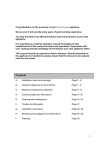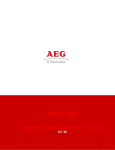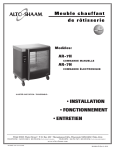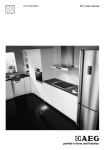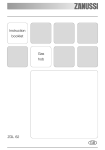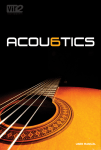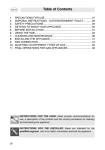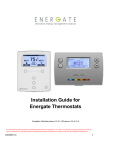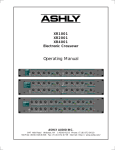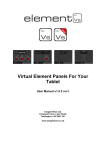Download User Manual - Porter & Charles
Transcript
Congratulations on the purchase of your Porter&Charles appliance. We are sure it will provide many years of great cooking experience. You may find that it has different features and characteristics to your last appliance. It is essential you read this operation manual thoroughly to fully understand all of the various functions and operations. Experiment with your cooking and take advantage of the features your new appliance offers. This manual should be retained for future reference. Should ownership of the appliance be transferred, please ensure that the manual is also passed onto the new owner. Contents A- Installation check and warnings Page 3 -7 B- Cooker Measurement-installation skirt board Page 7-8 C- Electrical Requirements Page 9 D- Using the appliance for the first time Page 10 - 11 E- Accessories F- Electronic timer Page 12 - 14 G- Gas cooktop control panel Page 15 H- Gas cooktop function Page 16 I Ceramic Cooktop control panel Page 17 L- Ceramic Cooktop Functions Page 18 M- Oven Functions & Control Panel Page 19 - 24 N- Cleaning and maintenance Page 25 - 29 O- Trouble shooting guide - Electrical wiring Page 29 - 31 P- Warranty Page 32 Page 11 – 12 2 A - Installation instructions check and warnings IMPORTANT: Please ensure that the cut out measurement, venting and wiring is as specified in the relevant section B of this manual. A licensed electrician with relevant qualifications must perform electrical work when installing or servicing the appliance. The supply cable and fuse rating must be suitable for the appliance. You must never repair or replace any part of the appliance unless specifically recommended in the operation manual. DO NOT LIFT COOKER BY THE FRONT DOOR AS THIS WILL DAMAGE THE OVEN Ventilation opening must not be covered or obstructed in any way. VENTILATION The room containing this cooker should have an air supply in accordance with local regulations. - All rooms require an open window, or equivalent and some rooms will require a permanent vent as well. For room areas up to 5 m2 an air vent of 100 cm2 is required. For room areas between 5 m2 and 100 cm2 an air vent of 50 cm2 is required. If the room is greater than 5 m2 and has a door that opens directly to the outside, then no air vent is required. If there are other fuel burning appliances in the same room local regulations should be consulted to determine the air vent requirements. DISCHARGE OF FUEL GASES Cooking appliances must always discharge the flue gases into special hoods (fig.1-C), which must be connected to chimneys, flue pipes or have direct access to the outside. If it is not possible to connect a hood, an electric fan can be fitted to a window or a wall (fig.1-E), which must be turned on when the cooker is on, as long as ventilation standards are strictly adhered to. Fig.1 3 RECOMMENDED VENTILATION HEIGHT - for ceramic cooktop model min. 24” above range - for gas cooktop model min. 30” above range When ranges are installed in close proximity to vinyl finish cabinets, those materials should be able to withstand temperature up to 75°C centigrade. Alternatively, heat insulating barriers should be installed to avoid any deterioration to the finish. The equipment must not be installed near inflammable materials, such as curtains, cloths etc. Pay particular attention to the position of the electric cable and gas pipe: they must not touch any hot parts of the oven The manufacturer will not accept responsibility for damages to cabinetry where manufacturer installation guidelines were not adhered to. CONVERTING THE GAS-SUPPLY TO THE HOB BURNERS Burners: auxiliary, semi-rapid, rapid, triple crown, griddle burner. These burners are all fitted with injectors designed to create a primary input of air gauged for each type of gas. This means that the air regulator does not have to be regulated. Proceed as follows in order to convert from one type of gas to another: remove the grids, covers, holed flame diffuser and the burner supports (fig. 7); replace the holed injectors as indicated in 7/C according to the type of gas used (see table 1); put the burner supports, flame diffusers, covers and grids back in position; regulate the minimum output following the instructions in paragraph 1.7. REGULATING THE MINIMUM OUTPUT OF THE HOB BURNERS Normal/valve taps: Ignite the burners and turn the knob to the maximum position. Remove the knob and insert a small flat-head screwdriver into the rod or through the holes on the side of the control panel, in accordance with the type (fig. 8 A/B). Loosen the by-pass screw by two turns in an anti-clockwise direction and rotate the rod to the minimum position. Adjust the previously loosened screws until the flame is lowered but stable, even when rapid changes are made from the maximum to the minimum position with the burner cold. If safety taps are fitted, let the burner run on minimum for a few minutes to ensure that the device does not cut in. If it does, increase the minimum. N.B. For liquid gas settings, the burner minimum must be set by fully tightening the tap by-passes 4 Fig.8 - - WARNINGS: If the burner flames accidentally go out, turn off the KNOB and wait for at least one minute before igniting. Using a gas cooker produces heat and humidity in the room where it is installed. Ensure the room is well ventilated by keeping all the natural air vents open or by installing an extraction hood with flue pipe. Intensive or extensive use of the cooker may require supplementary ventilation e.g. opening a window, or more efficient ventilation e.g. increasing the capacity of the mechanic ventilation, if installed. N.B. When the burners are alight, there must not be any draughts inside the room in that they may affect the flame or even blow it out. The operations indicated below must be followed by qualified personnel, in conformity with the regulations in force. The supplier refuses all responsibility for damages to person or property, resulting from the failure to comply with such provisions. The appliance is designed to be used near heat resistant pieces of furniture or kitchen cabinetry only. ELECTRICAL CONNECTIONS (FIG.7) Before carrying out electrical connection, be sure that the characteristics of the electrical system meet the specifications located at the bottom of the cooktop and the electrical system is provided with effective ground in compliance with the regulations and provision of the law in your country. The ground is required in all circumstances. If you wish a direct connection to the line, it is necessary to use a single pole switch, with a minimum opening between the contacts of 3 mm. suitable for the purpose and in conformity with the rules in your country (the yellow/green ground cable should not be interrupted by the switch). 5 ATTENTION Disregard of this precaution could cause the incorrect operation of the touch control system of the cooktop and effect the product warranty provisions. WARNING: All aspects of the installation must conform with the requirement of the Standards North America (within North America) wiring rules, as well as your local electrical and building codes and regulations, and any other applicable requirements and conditions of your local power supply authority. Your appliance must be properly installed and grounded by a qualified and licensed technician. 240 Volt 60Hz 30AMP single/40AMP double service Incorrect installation of the appliance, resulting from the kitchen maker not following the detailed installation specifications, can affect the appliance performance CONNECTION TO THE GAS SUPPLY: CURRENT INSTALLATION STANDARDS The cooker should be connected according to local regulations, using either a rigid or flexible connections. a) For building in: Use a continuous flexible stainless steel pipe, as per current installation standards, which can be extended to a maximum of 2000 mm.; the ends of the pipe must be fitted with an ISO 228/1coupling and gasket or an ISO 7/1 threaded coupling with mechanical gasket. b) For free standing: A non-metallic flexible pipe can be used as long as it complies with current standards and the following installation instructions are observed: the pipe must be longer than 400 mm and shorter than 1500 mm; it must not exceed 50°C in any point; it is not pulled or twisted; it cannot be choked and the entire edges, sharp corners or other similar hazards. Before connecting the non-metallic flexible pipe, the brass adapter and gasket supplied with the cooker and/or available form the reseller must be fitted to the pipe/gas train on the back of the cooker. The regulator provided should be positioned between the brass adapter and the non metallic flexible pipe. c) A certified gas plumber must complete the installation and meet with local regulation requirements for gas connections. Where the unit has an armour cable a certified electrician must complete the electrical connection. The white, or neutral wire will not be used and must be capped using a marrette. 6 WARNINGS: In order to prevent tipping of the appliance, must be installed a stabilized means. Please see the picture. The chain on the back of the range need to be fixed to the wall (PLEASE NOTE: The fixing hook is not provided as the type will depend on the construction of the wall to which it will be drilled and fitted. The installer should provide the fixing hook per customer request). B - Cooker Measurements ( 600x640x900-920 ) Measurements Please note that all dimensions provided are in millimeters (mm.) The sizes allow for only a small degree of error so all cut-outs must be precise and square If the range is placed on a base, measures must be taken to prevent the appliance slipping off the base 0 64 0 600 900-920 60 900-920 0 64 7 How to install the telescopic skirting board 60 cm. range fig. 1 fig. 2 fit the screw into the leg up to the shown level, (fig.1) then fit the leg into the hole then moving it side way (fig.2)and tight the screw until the leg is fixed fig. 3 fig. 4 By using the 3 self tapping screw,fit the first part of the skirting board (fig.3-fig.4 ) fig. 6 fig. 5 Insert now the telescopic part(fig.5 Then by using a little screwdriver lift the flexible bracket and with finger place it at 90° (fig.6)This will avoid to fall down the part fig. 7 fig. 8 The telescopic is in position to achieve the desired height level of the range.You must adjust the black plastic end cap of the leg ( fig8 ) 8 C – Electrical requirements WARNING: All aspects of the installation must conform with the requirements of the Standard North America (within North America) wiring rules, as well as your local electrical and building codes and regulations, and any other applicable requirements and conditions of your local power supply authority. A licensed electrician must perform the electrical work when installing this appliance. The supply cable and fuse rating must be suitable for the appliance WARNING: To avoid power borne interference, this appliance must be installed individually on a separate and distinct final sub-circuit. Voltage supply connection If the supply cord is damaged, it must be replaced by the manufacturer, its service agent or similarly qualified persons in order to avoid hazard When connected to a sub circuit, protected by a circuit breaker, it is recommended the circuit breaker be the same as the total rating of the appliance. To full disconnect the power supply, it is necessary to have a proper mean in the fixed wiring in accordance with the wiring rules. It must have full disconnection under overvoltage category III conditions. The range is supplied with a power cord and plug, which can be withdrawn from the wall socket Electrical Loads Oven Grill Oven fan and light 2350 W 2800 W 90 W Cearmic cooktop TOTAL RATING AT 208V 6400 W 8.70 KW TOTAL RATING AT 240V 11.45 KW Oven Grill Oven fan and light Gas cooktop TOTAL RATING AT 208V TOTAL RATING AT 240V 2350 W 2800 W 90 W 3.22KW 4.05KW 9 D – Using the Appliance for the first time After installation remove all notification labels (not identification or warning labels) and packaging materials. After cleaning make sure cleaned surfaces are thoroughly rinsed and wiped dry using a clean, soft cloth. Power on NOTE: oven will not operate unless the clock is set on manual position Burning in Before cooking in the appliance an initial pre-heating is required to burn off the fine oil film used to protect the elements for shipping. Select a cooking mode and set the oven temperature to 180°C. With the oven door closed, leave for approximately 5 minutes. Repeat the above step for each cooking mode. After completing the above make sure all controls are turned off. The oven is now ready for cooking and grilling DO NOT use aluminum foil on the base of ovens The use of foil on the base of the oven to avoid spillage and improve cleaning is not recommended. The bottom element is concealed under the base of the oven liner (not exposed). Foil or dishes with reflective qualities must never be placed on the base of the oven during cooking as the concentration of direct and reflected heat will damage the enamel surface. NOTE Damage resulting from such use is not covered under the provisions of the warranty. Initial heat up Some smoke and smell may be noticed during the initial heat up cycle. This should quickly dissipate, and is normal If abnormal levels of smoke during use are observed (i.e.: it is not food that is burning), have the appliance thoroughly checked. Don’t use the appliance as a space heater The appliance must never be used for warming or heating the surrounding room. Combustible materials must never be placed on or near the appliance. Do not leave children alone Children must not be left unsupervised in the area where the appliance is in use. Children must never be allowed to sit or stand on any part of the appliance. Wear proper apparel when using the appliance Loose fitting, hanging or highly flammable garments (such as synthetics) should never be worn while using the appliance. Use only dry pot holders 10 Moist or damp pot holders on hot surfaces may result in burns from steam. Do not allow pot holder to touch hot heating elements. Do not use a towel or bulky cloth when handling hot cooking utensils in the appliance. Oven compartments must never be used for storage Items, particularly flammable materials, must never be stored in an oven or near surface units. Do not use water on grease fires Fires or flame should be smothered using flameproof material or extinguished using a dry chemical or other suitable fire retardant. All installation, adjustments, and maintenance operations must be carried out by qualified personnel, in accordance with the enclosed instructions and current installation standards. The manufacturer accepts no liability for faulty installation, setting, handling and use of the cooker. When the cooker is not in use, ensure that all the knobs are in the off position; furthermore, if it is unused for a period of time, shut off the appliance’s main electricity supply. E - Accessories Your appliance should come equipped with the following items. 1 x Deep Enameled Roasting Pan with dual height reversible Grill Rack insert – ready for sliding into side rack positions 2 x Wire Oven Shelves that can be fitted into Retractable Slide Runners or for sliding into side rack positions Note: Additional oven shelves and pans are available as optional extras. 2 x side catalytic panels The oven shelf support consist of 5 positions. Always remember to position the racks before warming up the oven, and remove all the shelves and roasting pan before cleaning operations. 1 2 3 4 5 11 Cooling Fan The range is provided with a cooling fan motor to reduce the heat around the oven. The fan motor is controlled by a sensor, which will start when the oven is switched on and stop working when the temperature is reduced accordingly. This safeguards both the oven and the adjoining cabinets from the possibility of temperature damage. Safety Thermostat Your oven is fitted with an over temperature sensor that will automatically shut down your oven for a period if it is deemed to be overheating- this sensor is fitted to the rear wall of the oven, inside the outer case – it will only activate in extreme circumstances and is provided as protection to the appliance and the adjoining furnishings. If activated it will shut down the appliance for a short time and will automatically reset allowing normal operations – you should consult your service technician if the problem re-occurs. F - Electronic Programmer Operation The 24 hour clock allows the setting of automatic cooking options up to 24 hours in advance. 1 2 - Minus Time Button 3 + Plus Time Button Mode (Countdown Timer with Alarm, Cooking duration, Finish Cooking) Setting the time on the 24 hour clock IMPORTANT – NOTE FOR NEW INSTALLATION AND FIRST OPERATION 1- The clock will require setting when you first turn on the power (or following a power failure). 2- At power on, the relay contact is opened. The display and AUTO symbol flashes and time of day starts from 0:00. 12 3- Press PLUS and MINUS button simultaneously for minimum 3 seconds. The AUTO symbol goes out, POT symbol goes on, the DOT is flashing. With the PLUS button the time will advance slowly, and then speed up. If you over-shoot the desired time , use the MINUS button) 4- Press the MODE button twice to display the time of day setting mode. The oven will be in manual cooking mode. 5- The oven is now ready for use and to accept the selected cooking functions 6- The timer can be set for countdown up to 24 hours and for automatic cooking modes up to 10 hours and will countdown to zero. When zero is reached the alarm will sound. 7- Setting the timer: Press the MODE button for minimum 3 seconds. The BELL symbol is flashing and the display shows 0:00. Using the PLUS button advance the timer to the desired time. Once the countdown timer is set, the normal time of day will return to the display within seconds. If you wish to check how much time remains on the countdown, press the To MODE button for 3 seconds. The remaining time will be displayed. After 7 seconds the normal time will return to the display. 8- To silence the alarm press the MODE button for minimum 4 seconds Adjusting the tone of the electronic timer alarm. The tone is adjusted simply by pressing the minus button. There are 3 different tones from which you can select. To change the tone you press the “+” and “-“ simultaneously, then press the Mode button, ton will be displayed. Pressing the “-“ button while ton is in the display, will change the tone to the desired setting The electronic timer will store in its memory the last tone activated Manual cooking Once the time of day is set the POT symbol will be displayed. The oven is now in manual operation mode ready for you to select the desired cooking function and temperature Automatic cooking modes (Based on setting the duration “DUR”) Set function and temperature to the desired position For example: if you wish to cook for 45 minutes. Press the MODE button minimum for 4 seconds. Press the MODE button again. The AUTO symbol is flashing and the display shows “dur”. The display automatically switches over between "dur" display and 0:00. During this time you can set the duration time of 45 minutes by pressing the PLUS button (use MINUS button should you overshoot the required time). Release and the display will return to the normal time of day after 7 seconds. The AUTO symbol will also appear indicating that you have set the automatic cooking function. The oven will operate for 45 minutes only, turn off automatically and the alarm will sound. The AUTO symbol is flashing and the POT symbol will disappear. The alarm will turn off after pressing the MODE button. If you hold the MODE button down longer than 4 seconds the oven will return to the normal cooking mode. If further cooking is required, either leave on manual or repeat the above setting sequence. Note: If you have not turned the function and thermostat setting off, your oven will now continue to operate manually. The AUTO symbol will disappear and the POT symbol will reappear. Setting a cook stop time 13 1 Set the function and thermostat control to the desired position 2 For example: if you commence cooking and decide you would like the oven to turn off at 6.00pm. Press the MODE button minimum for 4 seconds. Press the MODE button two times again. The AUTO symbol is flashing and the display shows “End”. The display automatically switches over between "End" and time of day. During this time you can set the cooking stop time to 6.00pm, i.e.18:00 on the 24 hour clock, by pressing the PLUS button (use MINUS button should you over-shoot the required time). Release and The display will return to the normal time of day after 7 seconds. The AUTO symbol will also appear indicating that you have set the automatic cooking function. 3 The oven will continue to cook until 18:00 (6.00pm) and then switch off and the alarm will sound. The AUTO symbol is flashing and the POT symbol will disappear. The alarm will turn off after pressing the MODE button. 4 If you hold the MODE button pressed longer then 4 seconds the oven will return to the normal cooking mode. If further cooking is required, either leave on manual or repeat the above setting sequence. Note: If you have not turned the function and thermostat setting off, your oven will now continue to operate manually. The AUTO symbol will disappear and the POT symbol will reappear. Fully automatic – (Start Later – Stop Later) Your oven may be programmed to start, cook for the desired time and turn off automatically. This function is particularly useful in the preparation of the evening meal, should you be out during the day, it will be ready on your return home. For example if your cooking time is 45 minutes and you want the cooking to finish at 6.00 p.m. Press the MODE button minimum for 4 seconds. Press the MODE button again. Set the cooking duration time for say 45 minutes using the PLUS or MINUS button. Press the MODE button again. Set the stop cooking time to 6.00pm (18:00). Release and the display will return to the normal time of day after 7 seconds. The AUTO symbol will be displayed. Using the above settings, the oven is now programmed automatically to commence cooking 45 minutes prior to 6.00 pm. Then automatically turn off. When cooking is complete the AUTO symbol is flashing and the POT symbol will disappear and the alarm will sound. The alarm will turn off after pressing the MODE button. If you hold the MODE button pressed longer then 4 seconds the oven will return to the normal cooking mode. Canceling automatic settings To cancel a program: Press plus and minus button simultaneously for minimum 3 seconds. NOTE: On oven start up or possibly at other times, due to electricity supply deviations – the programmer may freeze on a function – if this occurs we recommend that, after checking other solutions without success, it is recommended that power supply be disconnected to the appliance and allow it to be in this position for some minutes before reconnecting. This may have a result of clearing the frozen position allowing you to reset the programmer for normal operation. 14 G - Gas Cooktop Control Panel Technical Characteristic table BURNERS 1 2 4 GAS N° DESCRIPTION 1 SEMI-RAPID 2 RAPID 3 AUXILIARY 4 WOK 3 NORMAL PRESSURE mbar INJECTOR DIAMETER 1/100 mm PROPANE 28 72 NATURAL 10 118 PROPANE 28 90 NATURAL 10 155 TAP BY PASS DIAMETER 1/100mm NOMINAL HEAT INPUT MAX. (bTU/H) 35 REG. 8.000 46 REG 11.500 PROPANE 28 55 35 NATURAL 10 90 REG. 5.000 17.500 15.500 PROPANE 28 115 65 NATURAL 10 200 REG. 1= semirapid burner 2= rapid burner 3=a uxiliary burner 4= wok burner 15 H - Gas Cooktop Functions B - Cooking Instructions Automatic start-up with valves Turn the corresponding knob anticlockwise up to the maximum position and press the knob. Once the burner has been started up, keep the knob pressed for about 6 seconds. Using the burners In order to obtain the maximum yield without wasting gas, it is important that the diameter of the pot is suitable for the burner potential (see the following table and fig.1). This is to avoid the flame extremities being larger than the base of the pot. All of the operating positions must be chosen between the maximum and the minimum ones, never between the minimum position and the closing point. The gas supply can be interrupted by turning the knob clockwise up to the closing position. NOTE: If there is no power supply, it is possible to light the burners with matches, setting the knob to the startup point (large flame, fig. 1). BURNERS Auxiliary Semi-rapid Rapid Wok POWER (MJ/h) POWER (Btu/h) 3.2 3000 6.3 6000 11.6 11000 17.9 17000 Ø of pots 10 - 14 cm 16 - 18 cm 20 - 22 cm 24 - 26 cm NOTE: When the equipment is switched off, always check that the knobs are in the closing position. If the flame should blow out accidentally, the safety valve will automatically stop the gas supply, after a few seconds. To restore operation, set the knob to the lighting point and press. While cooking with fat or oil, pay the utmost attention as these substances can catch fire when overheated. WARNING: -Do not use sprays near the appliance in operation. -Do not place unstable or deformed pots on the burner, so as to prevent them from overturning or overflowing. -Always turn gas off if moving a pot away from the appliance. 16 I- Ceramic Cooktop Control Panel Ceramic Cooktop Controls: Switch controlling the left, front Turning the knob clockwise activates the full hot plate. Switch controlling the left, back hot plate. Switch controlling the right, back hot plate. Turning the knob clockwise activates the full hot plate. Switch controlling the right, front hot plate. To operate Single (inner zone) and separate Dual (inner + outer zone) follow this procedure: a/ Inner Zone - rotate control knob in clockwise direction selecting power from positions 1 through 12. The inner zone only will operate. b/ Inner + Outer Zone = Full Power - rotate control knob clockwise through position 12 as above, then through to the Dot on control panel only - a click will sound (do not Rotate control knob all the way to OFF position as this will turn power OFF). Then rotate control knob backwards (anticlockwise) selecting power level from 1 to 12 as before. This will activate both Inner and Outer zones concurrently for maximum power. c/ To deactivate (turn off) Inner Zone or Inner + Outer Zone the control knob must be returned to the OFF position IMPORTANT: 1/ DO NOT TURN CONTROL KNOB ANTICLOCKWISE FROM OFF POSITION AS THIS WILL DAMAGE THE CONTROL MECHANISM - OPERATE SINGLE AND DUAL ZONES STRICTLY ACCORDING TO THE INSTRUCTIONS AS ABOVE. 17 L- Ceramic Cooktop Functions WARNING --If the surface is cracked, switch off the appliance to avoid the possibility of electric shock, for hob surface of glass-ceramic or similar material which protect live parts -- During the use the appliance becomes hot. Care should be taken to avoid touching heating elements of the cooktop and inside the oven. Accessible parts may become hot during use. Young children should be kept away. All operations relative to installation and electric connection should be carried out by qualified personnel in conformity with the regulations in force in North America The specific instructions are described in the booklet section for the installer NOTICE Use only flat pans with a sufficiently thick base, equal to or not much larger than the hot plate selected (fig.1) The containers should not have rough bottoms, otherwise scratching will occur. Do not switch the electric plate on without the pan over the plate. Do not cook any food directly on the hot area. Avoid overflows of liquid and should they occur clean away promptly. The appliance is not intended to be operated by means of an external timer or separate remote-control system. Switching on Set the power by rotating the knob, taking into consideration that the highest number corresponds with the maximum power. The pilot light is switched ON when at least one element is on. The residual heat indicator will light up when the temperature in any area is higher than 50°C. Cleaning Remove leftover and grease or spillage from the cooking surface with the special scraper (fig.3) (optional). Then clean the heating area thoroughly with a paper towel and ceramic cleaning products for the correct care of your appliance. Never use abrasive sponge or irritating chemical detergents such as over spray or spot removers. FIG-.1 18 M - Oven Functions & Control Panel Control Panel: 50 MAX 100 230 200 150 -- During use the appliance becomes hot. Care should be taken to avoid touching heating elements of cooktop and inside the oven. Accessible parts may become hot during use. Young children should be kept away. PREHEATING Preheating the oven is not essential, but you will achieve better results if you do. Some foods, particularly cakes and pastry, are better cooked in a preheated oven. Other foods, for example casseroles, cook just as well when cooked in a non-preheated oven but may need longer cooking times. For faster preheating select pizza mode and the required temperature and once the oven has reached the required level change to cooking mode/function for the task. To preheat the oven: 1- Set the mode required for preheating. 2- Set the oven to the desired temperature Preheating guide (for 180°C settings) Cooking Mode Preheat Time CONVENTIONAL 15-20 MINUTES OVEN FAN OVEN 15-20 MINUTES NOTE: Any food or other cooking utensils placed in the oven during preheating will affect the preheating time. The preheat time may also vary with installations. WARNING When using an alternative cooking mode for fast preheat, be sure to turn the cooking mode to your required setting before placing food in the oven 19 HINT: To allow for heat loss while placing food into the oven, preheat the oven 10-20°C higher and then reduce the temperature to your required cooking temperature. Always preheat the oven when cooking multiple dishes at the same time. Roasting guide. These cooking charts are intended as a guide only. Temperature and cooking times may vary to suit individual tastes. Type of Meat Approx. 450 grams = 1lb Beef Veal Lamb Pork Cuts of Meat Time per lb (allow) Oven Temperature 0 C Prime Rib, rolled sirloin bolar blade, Top Loin, New York Strip Sirloin Shoulder or leg (with bone or rolled) Leg, shoulder (loin or rolled) Leg loin 60 minutes per 2lbs 1800 – 2000 40 minutes per 2lbs 1800 - 2000 40-50 minutes per 2lbs. 40-50 minutes per 2lbs 90 minutes per 2lbs. 1800 - 2000 1800 - 2000 2200-2300 / 1800-2000 Pork leg should be cooked at a higher temperature for the first 15-25 minutes then reduced to lower temperature for remaining cooking time. Type of Poultry Size of Meat Time per lb Chicken Whole or pieces 30 minutes per lb. Duck 3lbs – 4.1lbs Turkey 5.4lbs – 21lbs 30 minutes per lb. + 35 minutes extra 20 minutes per lb. + 35 minutes extra Oven Temperature 0 C 0 180 - 2000 1800 - 2000 1800 - 2000 Turkey should be well basted and turned during cooking Type of Fish Cuts of Fish Time per lb Oven Temperature 0 C Fish Whole or fillets 10 minutes per lb. 170-1900C In Conventional Oven mode, fish should be covered for the first ¾ of the cooking time to help retain moisture. Baking guide. These cooking charts are intended as a guide only. Temperature and cooking times may vary to suit individual tastes. Oven Temperature 0C 1300 – under General Times Very slow Foods Suitable Small meringues, pavlova, custard, reheating 1300 - 1500 Slow Rich fruit cake, light fruit cake 1500 - 1800 Moderate Casseroles, deep butter cake Moderately hot Shallow butter cakes, sponges, biscuits, meat loaf, baked fish 0 180 - 200 0 20 2000 - 2300 0 230 – and over Hot Swiss roll, patty cakes, rock cakes, short crust pastry Very Hot Scones, Choux pastry DEFROST This function activates the fan , to allow controlled and hygienic defrosting. no heat is required, (in case you want to speed up the operation, you can set the thermostat knob to 50°C) As a general guide, the defrosting time for meat is approximately 15-20 minutes per kilogram. All foods may be defrosted using the Fan Forced Convection mode. It is important to note that NO temperature (0 Degrees) is selected when using this function. As a general guide, the defrosting time for meat is approximately 15-20 minutes per kilogram. . PIZZA In this position the fan and fan element together with the under oven element are engaged simultaneously. This is used for food that requires a concentration of cooking to the base, and allows the top to gently cook at the same time. For best results for pizza and similar items we recommend this function and may be combined with our optional pizza stone for perfect outcome CONVENTIONAL OVEN In this traditional mode, oven heat is provided from the top and under the oven compartment and is most suitable when cooking on a single shelf. For best results, arrange the shelves so the top of the food is near the centre of the oven. If cooking on more than one shelf, always preheat the oven and position the pans to allow as much free circulation of heat as possible. Depending on the food, you may need to rearrange the tray position during cooking. 1234- Adjust oven shelves to desired position/s. Select Conventional Oven mode. Set the oven to the desired temperature. When cooking is complete turn the oven off. HINT: If water is used in your cooking (such as water placed in a baking dish) the water will evaporate in the oven in the form of steam. The level of condensation will be reduced when cooking in fan oven mode where excess moisture is circulated and evaporates during the cooking cycle. 21 NOTE: Stand clear of the oven when opening the oven door as steam may escape rapid FAN ASSIST This style of cooking provides traditional cooking heating from top and bottom elements with the assistance of a circulation fan to ensure fast even results. This mode is most suitable for delicate cooking such as cakes, pastries, gateaux, biscuits and yeast dough. Best results when thermostat is set to 150-180 degrees – depending on recipe. This function is also excellent as the fastest oven pre heat, engaging maximum power to heat the oven to a selected temperature before selecting an appropriate function and temperature for a task. CLASSIC BAKE (bottom of double oven) In this mode, oven heat is provided from under the oven compartment. This is most suitable for cooking food which requires a well cooked base or where minimal browning is required. 1234- Adjust oven shelves to desired position/s. Select CLASSIC BAKE. Set the oven to the desired temperature. When cooking is complete turn the oven off. HIGH BAKE The HIGH BAKE mode uses the oven fan to circulate air with heat from the under oven element. Quick and consistent heat is evenly distributed throughout the oven. The results are quick, not unlike a microwave oven. With the circulation of heat, foods cooked with high bake mode retain a crisp, dry texture on the outside especially pizza, pastry and other foods where you want the base to be well cooked. HIGH BAKE is also excellent for re-heating. 1234- Adjust oven shelves to desired position/s. Select HIGH BAKE mode. Set the oven to the desired temperature. When cooking is complete turn the oven off. FAN FORCED CONVECTION – most commonly used function 22 In this mode the oven fan circulates heat from behind the fan cover to give a more even temperature throughout the oven. The even heat provides similar cooking results for each portion of food. Although temperatures for cooking foods in this type of oven are generally the same as required by a conventional oven, when cooking foods that require lengthy cooking cycles a fan forced oven normally cooks more quickly, saving time and energy. Always place the food as near to the centre of the oven as possible. If cooking on more than one level, arrange the pan positions to allow for free circulation of heat. 1234- Adjust oven shelves to desired position/s. Select FAN OVEN mode. Set the oven to the desired temperature. When the cooking is complete turn the oven off. HINT: Always preheat the oven when cooking on multiple shelves at the same time. Depending on the food, you may need to rearrange the tray positions during cooking. FAN GRILL NOTE: Door must be closed in Fan Grill Mode Fan grilling is a combination of direct heat and circulated hot air which gives the appearance and flavor similar to rotisserie cooking which is ideal for single level roasts. Direct infrared heat from the grill element is circulated by the fan to cook the food, which should be positioned as near to the centre of the oven as possible. For best cooking results, it is recommended that food be turned once only. 1- Oven door must be closed in Fan grill mode. 2- Place food on grill rack and pan supplied (ensure grill rack is inverted to the high position to allow best circulation of air) as close to the centre of the oven as possible. 3- Select FAN GRILL mode. 4- Set the oven to the desired temperature. (see note below and refer to FAN GRILL temperature guide). 5- When cooking is complete turn the oven off. NOTE: Large grill pans or roasting dishes can restrict the circulation of air in the oven. To prevent moisture condensing in the cooler lower sections of the oven, preheat the oven for approximately 10 minutes, using CONVENTIONAL OVEN or HIGH BAKE modes, prior to fan grilling. NOTE: The temperature setting in FAN GRILL mode must not exceed 200°C. The grill element has a safety shutdown at approximately 200°C. Fan grill guide These cooking charts are intended as a guide only. Temperatures and cooking times may vary to suit individual tastes. Type of meat/poultry/fish Chicken – whole Oven Temperature 0C 1750 - 1850 Approximate Cooking Time 30 minutes per lb 23 pieces Lamb - loin/rack Chops - medium/rare Chops – medium Beef- Steak – rare Steak – medium Steak – well done Pork Chops – medium/rare Chops - medium Chops – well done Sausages- thin thick Fish fillets 1850 - 1950 1750 - 1850 1750 - 1850 1750 - 1850 1750 - 1850 1750 - 1850 1750 - 1850 1900 - 2000 1750 - 1850 1750 - 1850 1750 - 1850 1750 - 1850 1750 - 1850 15-20 minutes 25 minutes per lb 10-12 minutes 14-16 minutes 6-8 minutes 8-12 minutes 12-15 minutes 6-10 minutes 10-12 minutes 12-15 minutes 8-10 minutes 12-14 minutes 10-14 minutes Sliced vegetables Tomato halves Crumb Based dishes Pasta dishes 1800 - 1900 1900 - 2000 1750 - 1850 1750 - 1850 20-30 minutes 6-8 minutes 20-30 minutes 20-30 minutes FULL GRILL & HALF GRILL This mode of cooking uses infrared heat from the top of the oven to cook foods to your requirements. Half grill engages only the inner band of the top element and is suitable for smaller volumes and has a consequently lower energy usage. This method of grilling in the oven is recommended for short duration (5 minutes or less) grilling only, which is ideal for toasting (see note below). Foods with higher fat content or foods, which require more than 5 minutes grilling time, should be grilled using the FAN GRILL mode. When in GRILL mode the oven door should be opened. 1- Commence grilling from a hot oven whenever possible. 2- Place food on grill rack and pan supplied. 3- Position the shelf to your preference. 4- Select GRILL mode and, turn to your desired heat setting. 5- When cooking is complete turn the oven off. NOTE: The grill element is controlled by the oven thermostat. Once the temperature in the oven has reached the selected temperature the element will switch off, and then on again, when more heat is required. 24 N - Cleaning and Maintenance 1. Cleaning and maintenance Proper cleaning and care of your appliance is essential to maintain its appearance and durability. NOTE: People with sensitivity to cleaning chemicals must take the necessary precautions. It is recommended that protective gloves be worn while cleaning the appliance. Routine cleaning of the appliance should only be performed when the appliance is at room temperature. Do not use any acid or caustic cleaners, abrasive powders or scourers on the interior or exterior of the appliance. Substances or items with these properties may discolor or damage the finishes of your appliance. If any abrasive, acidic or caustic substance or cleaning agent should come into contact with the appliance, rinse off immediately with water, taking special care to avoid injury if surfaces are hot. When using the appliance, it may be soiled by food spills and spatters or foreign items such as plastics accidentally coming into contact with warm or hot surfaces. Foods which contain acidic substances or sugar can discolor or damage enamel finishes. The enamel interior of the oven is a hard durable finish which is resistant to wear and discoloration. However, to maintain the appearance and durability of the finish any spills must be wiped off immediately. This should be done even if still hot and necessary precaution must be taken to avoid injury. Once cool the affected area should be thoroughly cleaned and rinsed using non-abrasive, mild cleaning detergents and water. 2. Care for stainless steel No metal is indestructible and certain procedures should be followed to maintain the finish and durability of stainless steel. Never leave stainless steel items unwashed. The surface responds best to gentle cleaning methods, scouring materials and harsh abrasives should not be used. Frequent washing with water (preferably hot) is the recommended treatment, followed by rinsing with fresh clean water and wiping dry with a soft cloth or paper towel. A little soap or detergent may be added to the washing water but too much can produce a cloudy film over the appliance. Use of steel wool is not recommended but stainless steel wool (a fine mesh pad) is an excellent cleaning aid. Oil or grease in the washing water can leave a rainbow film when it dries. It can easily be removed by simply using polishing and cleaning methods described previously. Thoroughly rinsing with clean water is the real secret and it is surprising how easily stainless steel can be kept sparkling clean by using the above simple method. Never leave stainless steel to dry by itself. 3. Only place cookware on oven shelves. Other surfaces such as trims are not totally resistant to hard materials or direct heat and may be permanently damaged by such use. 25 Recommended cleaners Mild detergents and warm water together with a clean, soft, non-abrasive cloth achieve good results for normal cleaning. Diluted washes with ammonia and water should rinse away any adhesive residue or gummy deposits on the appliance surfaces. Eucalyptus oil (small amounts) is also good for removing adhesive residue. Alcohol based products (eg: methylated spirit, etc.) are not recommended. Brand name cream cleansers and concentrates, without abrasive qualities, can be used in small amounts to break down greasy deposits and dirt. After cleaning make sure cleaned surfaces are thoroughly rinsed to prevent any risk of baked on cleaner residues and wipe dry with a clean, soft cloth. NOTE: When cleaning stainless steel surfaces AEG recommend 3M brand stainless steel cleaner. Other reputable brand cleaners specifically formulated for cleaning stainless steel may also be acceptable. Do not use steel soap pads or abrasive scourers of any kind. The abrasive qualities of these pads will ruin the even brushed finish of the stainless steel and any residual metal fibers may corrode causing a rusty/dull appearance. Metal polishes with abrasive qualities are also not recommended. WARNING: Do not use any acid or caustic cleansers or harsh abrasive cleaners or sharp metal scrapers to clean the oven door glass since they can scratch the surface, which may result in shattering of the glass. Routine cleaning Ensure all controls are in the off position and the appliance is cool before cleaning. When wiping stainless steel surfaces with a brushed finish, wipe in the same directions as the brushing. To clean the oven interior, fully open or remove the door (top opening type, see opposite page) for better access while cleaning. The shelves and shelf guides can be lifted out for cleaning by removing the relevant thumb screws. The shelves and shelf guides can be washed manually but are also dishwasher safe. If using commercial oven cleaners, choose only non-caustic cleaners and follow the manufacturer’s instructions. Avoid contact with elements, rubber door seals and exterior surfaces. After cleaning make sure all surfaces are thoroughly rinsed and wiped dry with a clean, soft cloth. DO NOT USE A PORTABLE STEAM CLEANER TO CLEAN THE OVEN. 26 Self Cleaning Panels The range is equipped with 3 panels ( 2 sides and rear ). They are attached to the sides by removing the rack guides assembly and placing the self cleaning panels against the oven side. The rear panel is attached with screws, ensure that the «rough» side is facing out. These liners are «self cleaning» during the cooking. If residue remains on them after cooking, empty the oven of food, and remove all shelves and pan, and turn the selector to Conventional oven ( top and bottom element ) and thermostat to MAX; 15-20 minutes should be adequate to clean the panels using this method. How the Self cleaning panels work. The self-cleaning oven panels go through a special enamelling process which ultimately creates a rough surface (this is the side which should face outwards in the oven). Because of the structure of the surface, it is extremely porous and attracts oxygen. When the splashes of grease hit this surface it immediately spreads. In this way, immediate oxidization of the grease occurs, and it ultimately disappears while the oven is in general use at standard cooking temperatures. The self cleaning panels are located on the sides and on the rear of the oven, and are designed to cope with fatty stains very efficiently. For stains on the bottom of the oven, the usual causes are sugar or starch overflows. The self cleaning panels are manufactured using a special enamelling process The base of the oven should cleaned by using soapy water ( see procedure to page 24-25 ) on a soft clean and newspaper BEWARE: Never use silicone films (polish or cleaners) on self-cleaning panels - they will be rendered useless. Similarly, NEVER try to wash with detergent, or use abrasive cleaners on the panels 27 Removing Oven Door The oven door can be easily removed for better access while cleaning. To remove the oven door: 1. Open the door fully and fit the supplied pin in the hole. 2. Raise the door slightly, holding the sides of the door about half way up. Make sure the pin stays in the hole the whole time. Lift the door gently. This should disconnect the hinges from the oven frame. 3. Remove the door by continuing to raise it while pulling the door away from the oven. When handling the door be careful not to dislodge the pin off the hole. If the pin does dislodge, the hinge will have to be closed by hand and the pin re-fitted onto the hole before re-fitting into the oven. To re-fit the oven door: i. Holding the door at an angle to the oven, slide the hinges into the oven frame, making sure that on each side the top curved arm fits into the top slot and the lower arm fits into the bottom slot. ii. Make sure the hinges are pushed as far as they will go and the lower arm engages into the plate mounted in the oven frame. iii. Open the door fully and ensure the pin fully disengages from the hole. The door can now be opened and as normal. To change a light globe : 1-Gently remove the glass cover . 2-Pull the light globe and push in a replacement globe. 3-Replace the glass cover making sure it fits correctly into place. Recommended globe: Halogen 40 W 28 DROP DOWN TOP ELEMENT The removal of a single screw at the front of the upper grill element allows the grill to drop down to facilitate the cleaning of the oven ceiling. On completion of cleaning, simply replace the grill element and secure with the screw. To avoid smoking, use a clean, damp cloth to regularly clean oil and fat splatters from the exposed drop down grilling element.The fan cover can be lifted out for cleaning separately by removing the retaining screws. The fan blade can also be removed for cleaning if necessary. NOTE: that the fan blade nut has a left-handed thread. O - Trouble shooting guide Symptom No power supplied to appliance Oven power is on but appliance does not operate Oven power is on but there is no heat Rubber seal has gap/s at bottom and ends do not meet Display is flashing, is only part illuminated or is cycling through various displays. Remedy Has the power been disconnected? Check the meter box. Has the main fuse or circuit breaker blown or tripped? Oven may be set on AUTO (see auto programmed cooking) Oven may be set on AUTO Oven temperature may be set OFF Mode may be on incorrect selection Correct - doors are sealed this way for oven venting purposes Turn power supply to appliance off, wait 30 seconds and turn power on. Reset clock 29 30 D 4 5 6 7 8 9 10 1 a 2 a 3a 4a 5a 6a 7a 8a 9 a 10a 1 2 3 H F G E 1 C O 2 R S 1A 1 B Y M T I A = TERMI NAL BLO CK C = OVE N THERMOS TAT E = OV EN LAM P G = YE LLOW P IL OT LAMP I = TOP E LEM ENT M = BOTTOM E LEME NT O = FAN ELE ME NT Q = SWI TCH CHAINE T = S AF ETY THERMOS TAT L A Red(L1) B = ELE CTRONI C TIM ER D = OVEN SWIT CH F = RED PIL OT LAMP H = FAN MOTOR L = GRIL L EL EME NT N = S PARK CANDLE P = S PARK GE NE RATOR R = COOLING FAN S = COOL ING FAN CLIX ON N 4 2 5 P 3 1 ELECTRICAL WIRING DIAGRAM FREE STANDING COOKER 60 CM. GAS COOKTOP Green(Ground) Black(L2) 31 Q P- Warranty Porter&Charles products are designed and built to the highest standards. We expect your appliances to provide many years of trouble free enjoyment. In the event of an appliance requiring attention, each appliance is covered by a 2 year warranty from the date of purchase. Refer to warranty policy for complete terms and conditions. Coverage is for costs of parts and labor for appliances in capital cities & metropolitan areas. We reserve the right to charge directly for handling expenses outside the metropolitan region. Porter&Charles products are supported by a national service support system. Call our customer service department for attention. Please retain your invoice Porter&Charles to quote should you require service assistance. This will identify your product for our priority service back-up. Please attach your invoice to this manual for easy future reference. PORTER & CHARLES INCORPORATED 871 Cranberry Court Oakville, ON L6L 6J7 Canada Telephone: 1-866.699-4973 Telephone: 905-829.8389 Facsimile: 905-829.8409 For Service & Spares: EURO-PARTS 1-800.678-8352 Important: Please record details of your purchase below and mail or fax to: ----------------------------------------------------------------------------cut along line -------------------------------------------------------------- Porter&Charles Name:_____________________________ Tel no______________________________ Address: ______________________________________________________________________ City: ______________________ State:_______________ Zip Code: _______ Where purchased: _________________________ Purchase date ;________________ Items purchased:________________________________________________________ 32 Serial No. (s): ____________________________________________________________________ 33



































